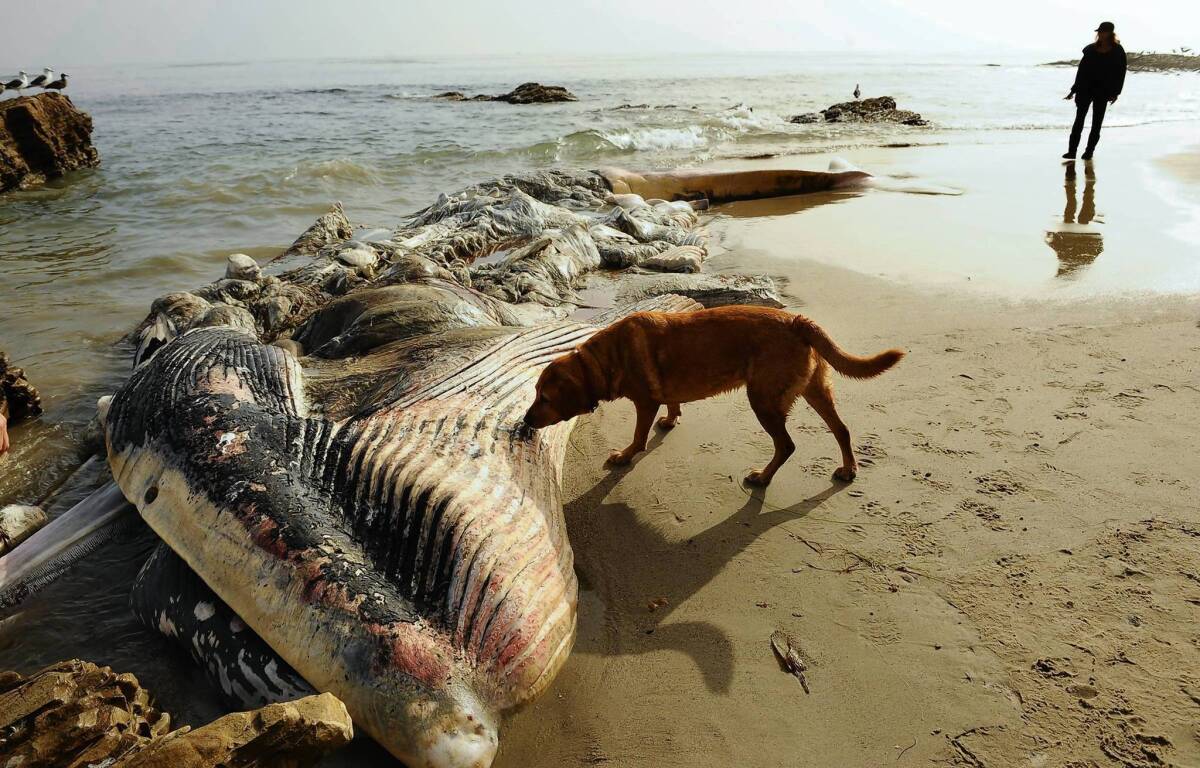Disposing of decomposing whale is an outsize problem in Malibu

- Share via
It was a magnificent beast when it washed ashore under the bluffs in Malibu: A 40-foot fin whale, a male, dark gray on top, a rich cream below that glistened in the surf and sun.
“It was sad to see it out of the water,” said Jeff Hall, marine mammal coordinator with the California Wildlife Center, a nonprofit wildlife hospital. “But it was a beautiful animal. It was in really, really great condition.”
By Thursday … not so much.
After four days of being pounded by the surf, devoured by gulls, poked at by gawkers and probed during a necropsy, magnificence had given way to a decomposing mess of protruding bones and ghastly strips of blubber — and a full-fledged state of government paralysis.
“There isn’t really a protocol for this,” Hall said.
The 40,000-pound whale, which is endangered but a not-uncommon sight off the Southern California coast, washed up Monday at Little Dume, a small beach between Paradise Cove and Point Dume State Beach. The spit of sand is at the foot of a towering cliff, below Barbra Streisand’s neighborhood — massive estates of groomed lawns, swimming pools and tennis courts.
After a brief period of appreciation, it was time to figure out what to do with it. That’s when the troubles began.
The lifeguards said they were game, but weren’t sure what to do. The city of Malibu said the county would probably take care of it, but the county insisted Little Dume is a private beach, which it is not. Then local officials said the state might take care of it, but the nearest state property appeared to be nearly a mile to the southwest.
“There have been some issues with jurisdiction,” said Los Angeles County Fire Inspector Quvondo Johnson.
Then there were more practical hurdles.
The leading strategy was to tow the whale out to sea. That would require a robust high tide — and that wasn’t expected until this weekend. Even then, officials weren’t sure they had the equipment to pull it off, though at one point there was discussion of adding a tugboat to the mix. Then there was the possibility of Whale Tale II; there were no guarantees, said California Wildlife Center Executive Director Cindy Reyes, that the whale wouldn’t “wash up on someone else’s shore.”
Officials then weighed burying the whale. But they couldn’t figure out how to get bulldozers and the like down to the beach, and even if they could, the beach appeared too rocky to dig a big enough grave. One idea after another came and went — carving up the whale on the beach and hauling off the chunks; dousing the flesh with diesel fuel and setting it ablaze.
Meanwhile, the carcass began falling apart. Wildlife experts suspected the whale might have been struck by a vessel, but wanted to confirm that. That required a full necropsy — which meant taking fecal and urine samples and removing internal organs. The whale had arrived with a bulge near its spine; investigators sliced that open, too, and removed a pile of broken bones that were sent off to a lab for analysis.
Decomposition set in. So did the smell — the acrid scent of long-expired seafood.
“Not pleasant,” said Olivia Damavandi, a spokeswoman for the city of Malibu.
Still, dozens walked down the beach to pay their respects. One onlooker was seen covering her nose with a pink scarf as she paced around the carcass. Some visitors brought their dogs, who sniffed the remains and slunk away.
“It’s hard to tell what I’m even looking at,” said David Greenbaum, 30, who lives on the nearby cliffs.
By Thursday, the carcass didn’t much resemble a whale anymore. Daniel Osei, 25, of Chatsworth, pointed to a black dot on the whale’s head and a long piece of flesh splashing in the waves, and speculated that they were the whale’s eye and tongue, respectively.
“It’s sad to see it like this,” he said, after having his picture taken in front of the dead whale.
By now, officials said late Thursday, towing the carcass to sea was no longer an option. “It’ll just break apart and make a big mess,” said Roy Stearns, a spokesman for the California Department of Parks and Recreation.
If that’s the case, remnants of the whale could be around for days to come.
“If you want to live here, this is what nature gives you,” said Brandon Batty, 30, another visitor. “It gives you beautiful sunsets. And sometimes it gives you dead animals.”
Times staff writer Ashley Powers contributed to this report.
More to Read
Sign up for Essential California
The most important California stories and recommendations in your inbox every morning.
You may occasionally receive promotional content from the Los Angeles Times.












